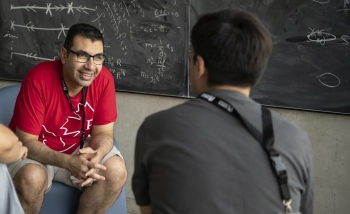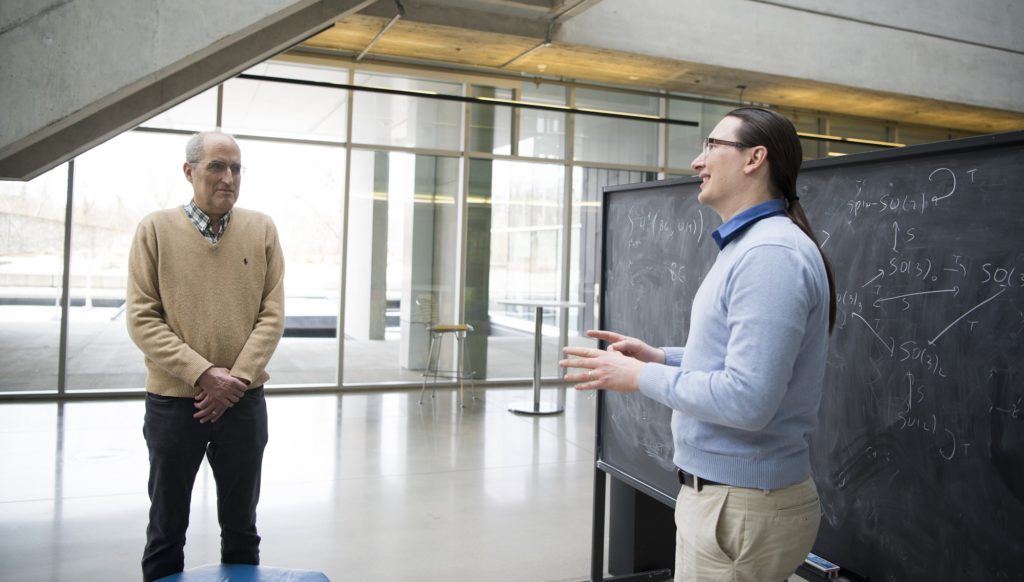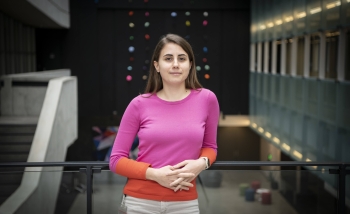Almost 400 years ago, Galileo declared that nature is “written in the language of mathematics.” Since that time, the relationship between mathematics and science – especially physics – has only strengthened. Unfortunately, the universe doesn’t come with a guidebook that explains which mathematical ideas can be used to explain which natural phenomena.
Sometimes, the connections are relatively straightforward. For example, Galileo found the mathematical formulas that govern the motion of simple pendulum, and of balls rolling down an incline. But as the physics gets harder, so does the math. When Newton tried to understand how one variable changes moment by moment with respect to another, he found he needed an entirely new kind of mathematics (what we now call calculus; as it happened, Gottfried Leibniz developed it at the same time). And when Einstein was developing his general theory of relativity, he found that he needed to make use of non-Euclidean geometry – which, luckily, had been invented around 60 years earlier by the German mathematician, Bernhard Riemann.
Indeed, today’s mathematics can be so involved that it’s hard to tell if two branches of mathematics are related to each other, let alone to the physical world. And vice-versa: in some areas of physics, we’re still in the process of discovering which mathematical tools are needed and learning how to develop them.
This tangle is giving rise to a rich interplay across disciplines, in which physicists can learn from mathematicians, and, perhaps surprisingly, mathematicians can also learn from physicists. That is where Davide Gaiotto comes in.
Fittingly, Gaiotto holds the Krembil Galileo Galilei Chair in Theoretical Physics at Perimeter. His particular interest is quantum field theory (QFT), a theoretical framework for modelling the behaviour of subatomic particles. (As Gaiotto points out, it makes more sense to talk about them in the plural, quantum field theories.)
The origins of QFT go back almost 100 years, to the first attempts to combine quantum mechanics with theories such as electromagnetism. Since then, QFTs have proved to be incredibly successful – and invaluable in describing the real world. They underlie the Standard Model of particle physics, the framework that accounts for the known forces of physics (with the exception of gravity). Some of its predictions agree with observations to an accuracy of one part in 1010. And yet, there’s still a great deal about QFT that remains to be discovered. “We still understand very little of it,” Gaiotto says. He adds, “It’s really hard!”
A powerful sum
The good news is that mathematicians and physicists are collaborating more than ever before – a collaboration that was sparked around 20 years ago, Gaiotto says, when string theory (an attempt at a quantum theory of gravity) first gained widespread attention. “In the process, mathematicians got interested in quantum field theory, and physicists got interested in certain mathematical tools,” Gaiotto says.
Many of those tools involve something called the Langlands program. Named for Canadian mathematician Robert Langlands, the Langlands program involves proposed connections, or bridges, between a number of seemingly disparate branches of mathematics. In particular, it suggests bridges between number theory (the study of integers, especially prime numbers) and analysis (an umbrella group of ideas involving continuous curves and surfaces, of which calculus is the best-known example).
At first glance, these seem quite different. Numbers are discrete entities, while curves and surfaces are continuous; it’s not immediately obvious why they should be related at all. But Langlands figured we just weren’t looking hard enough. Back in 1967, when he was 30 years old, he wrote a letter to André Weil, one of the mathematical luminaries of the time. In the 17-page letter, Langlands outlined the nature of the bridges as a series of conjectures. In an accompanying cover note, he urged Weil to consider them as “pure speculation.” He added: “If not – I am sure you have a waste basket handy.”
The waste basket would not be necessary. Langlands was on to something. (Earlier this year, he was awarded the prestigious Abel Prize, often considered the mathematical equivalent of the Nobel.) In fact, mathematicians have spent much of the past half century trying to prove the various conjectures that make up the Langlands program; it is sometimes referred to as a “grand unified theory of mathematics.”
A key issue is the nature of the connection between these mathematical structures and the physics of quantum field theory. What, exactly, does it reveal about the physical world?
“They [the mathematicians] are still far from being able to understand quantum field theory completely,” Gaiotto says. “But at least they’re already learning to do calculations that the physicists didn’t know how to do.” The mathematicians are also getting something in return: “They’re slowly coming to accept this idea that quantum field theory is a big lump of knowledge that is waiting to be unpacked.”
Jim Arthur of the University of Toronto, one of Canada’s leading mathematicians and a former student of Langlands, agrees. “To me, it seems there’s a very striking analogy between the Langlands program and quantum mechanics,” he says.
A fertile intersection
The equations that crop up in the Langlands program, Arthur suggests, are akin to the famous Schrödinger equation, which governs the evolution of quantum mechanical systems. “If you apply the same kind of analysis to [the Langlands program] that physicists apply to the Schrödinger equation, you get the analogue of energy levels,” he says. “You get discrete numbers.”
In other words, the mathematicians who have immersed themselves in the Langlands program may have something to offer the physicists who have been struggling to make sense of QFT; quite possibly, they can help physicists better understand these exotic mathematical structures.
Quantum mechanics describes things that come in discrete units, like the energy levels allowed within an atom. Meanwhile, most physical theories involve fields, which are continuous. Anything that can help connect these two ways of parsing nature could pay off in the world of particle physics.
For Gaiotto, the key idea is something called the geometric Langlands duality – a reformulation of the original bridge conjectures expressed in terms of algebraic geometry (the study of complex, non-Euclidean structures). In 2006, Edward Witten of the Institute for Advanced Study and Anton Kapustin of Caltech discovered a connection between the geometric Langlands duality and S-duality, a property of certain quantum field theories such as supersymmetric gauge theory.1 (S-duality is somewhat analogous to the connection between electricity and magnetism, explains Miroslav Rapčák, Gaiotto’s PhD student: if you swap electrical and magnetic charges, the mathematical structures stay the same. S-duality is like a supersymmetric version of that.)
Edward Witten and Davide Gaiotto collaborate during a conference at Perimeter, May 2018.[/caption]
Gaiotto’s work builds on what Witten and Kapustin had begun. Witten and Kapustin had been investigating the dualities that link various mathematical structures in the geometric Langlands program, and their relation to physical objects. They’d managed to show that QFT predicts the existence of such relationships, and that certain mathematical objects would encode the properties of particular physical objects.
They also identified which physical objects were responsible for the most important mathematical objects on one side of the duality. However, they lacked a generic method for translating from the physical side to the mathematical side, and for working out a physical description of the objects whose existence they’d predicted.
Later, in collaboration with Witten, Gaiotto and his colleagues were able to identify these dual physical objects, but couldn’t immediately find a way to compute the corresponding mathematical objects.
“For me, the puzzle was that I had these quantum field theory configurations, which clearly had implications for the Langlands program,” says Gaiotto. “But I could not do calculations with them, and that bugged me.” He says that last year he finally had the tools needed to “sidestep the main computational obstruction,” as he puts it. His breakthrough revealed the connection between the physical and mathematical structures. And with that, he was in a position “to do actual calculations.”
A spectacular breakthrough
The breakthrough involved applying vertex operator algebra to the problem. Vertex algebras, Gaiotto explains, are like Rosetta Stones that can help the mathematicians and the physicists understand each other. Gaiotto showed that calculations involving physical objects could be treated as vertex algebra calculations; he created a “dictionary,” as he puts it, for “mapping physical objects to vertex algebra objects.” The result sheds a light on “a web of mathematical dualities, which extend Langlands [program],” he says.
It’s a significant breakthrough, according to those who work in the field – “quite spectacular,” as Witten describes it. “He has made remarkable progress in understanding the geometric Langlands correspondence,” Witten said by email. “It is amazing to me how he has been able to bridge the gap between what could be understood by physics-based methods and what the mathematicians are able to appreciate.”
Gaiotto’s work has attracted widespread interest, and was the focus of a three-day workshop at Perimeter in May, titled “Gauge Theory, Geometric Langlands, and Vertex Operator Algebras.” Witten and other leading specialists were in attendance.
With geometric Langlands now at least partially tamed, Gaiotto hopes the collaborations between mathematicians and physicists will continue. “I see very fruitful developments in the future, in the interaction between physicists and mathematicians,” he says. After all, the mathematical structures he’s been exploring are very rich; there’s much more out there waiting to be discovered. It’s like those old maps from the Age of Exploration, he suggests. “There are a bunch of trade routes that you’ve been following, a few pieces of land that you understand, but 99 percent of the map is just sea monsters.”
He also hopes that more light will be shed on quantum field theories. That’s tricky, though, because the mathematics is very rich, and – Galileo’s dictum notwithstanding – it’s far from clear that all of it applies to the universe we live in. It may very well be that only some parts of the Langlands program will bear fruit that turns out to be relevant for physicists. But Gaiotto’s okay with that.
“Personally, I’m interested in quantum field theory as its own subject,” he says. “At this point, I like it enough that, even if it didn’t have any applications to physics, I would still pursue it. The fact that it has applications to physics is an extra bonus.”
Dan Falk (@danfalk) is a science journalist based in Toronto. His books include The Science of Shakespeare and In Search of Time.
1. Supersymmetry (SUSY) proposes a relationship between two basic classes of elementary particles: bosons, which have an integer-valued spin, and fermions, which have a half-integer spin. In supersymmetry, each particle from one group would have an associated “partner” particle in the other, the spin of which would differ by a half-integer. These super-partners have not yet been observed in nature. Gauge theories are a class of quantum field theories in which the variables that describe the field remain unchanged, or invariant, under certain transformations. This property gives the theory a certain symmetry, which in turn restricts how the field can interact with other fields and particles. A supersymmetric gauge theory is a theory that’s consistent with supersymmetry, and which also has internal gauge symmetries.
Further exploration
About PI
Perimeter Institute is the world’s largest research hub devoted to theoretical physics. The independent Institute was founded in 1999 to foster breakthroughs in the fundamental understanding of our universe, from the smallest particles to the entire cosmos. Research at Perimeter is motivated by the understanding that fundamental science advances human knowledge and catalyzes innovation, and that today’s theoretical physics is tomorrow’s technology. Located in the Region of Waterloo, the not-for-profit Institute is a unique public-private endeavour, including the Governments of Ontario and Canada, that enables cutting-edge research, trains the next generation of scientific pioneers, and shares the power of physics through award-winning educational outreach and public engagement.
You might be interested in


Perimeter Hosts Strings 2023: Spotlighting new directions and uniting a community
September 22, 2023

